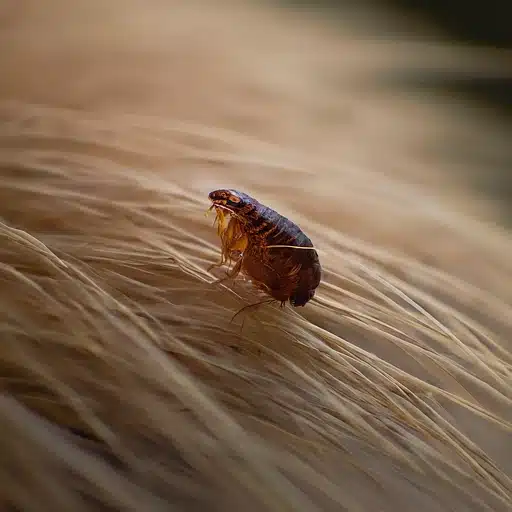In past years, we have had light winters with warmer trending weather here in the Tulsa area. As with many things this year, I don’t think that 2020 will be nice to us in this area. Colder than normal forecasts, ice storms and winter precipitation are likely expectations. But could there be a possible silver lining to this trying year? Many people will make the claim that colder winters tend to kill off particularly obnoxious pests. But is this true? Do fleas die in the winter? Fleas, like many insects, have developed ways to survive winter. Flea eggs, pupa and adults that live on hosts are all equipped to survive the winter.
Fleas have many ways to survive the winter. The adult flea’s highest priority is to find a host that it will live its entire life on. When attached to a host, it has an endless supply of food, warmth and protection. This warmth will carry a flea through the winter and well into the spring and summer months. Eggs and cocoons will lie dormant until warmer weather, or a suitable host comes by.
LIFECYCLE
The cat flea, the most common flea in North America, goes through a complete metamorphosis. This metamorphosis includes the egg, larvae, pupa and reproductive adult. A female flea will lay eggs on her host. In her lifetime, she can lay up to 2,000 eggs in her lifetime. These eggs will fall off of the host, usually in or around the animals den or bedding.
These eggs will lie dormant until either it is warm enough to survive, or if a vibration, signifying a host is near, occurs. At this point, the larvae emerges, looking to make a meal of flea dust. Flea dust is refuse from adult fleas in the area. This dust contains undigested blood for the larva to feed upon. After 5 to 10 days, the larvae will spin a cocoon, and lie dormant until, again, warmer weather or a possible host near by. Once it emerges from the cocoon, it will come out as a reproductive adult an immediately search for a host.
SURVIVING WINTER
Most fleas and other insects need at least fifty degree temperatures to survive and thrive. Insects use many different ways to overwinter. Some alter their bodily fluids to work as “antifreeze” to keep from freezing. Some find insulated places to lie dormant such as under tree bark or in the ground. Some, such as the snow flea, synthesize a special protein that keeps vital organs from freezing, but allow other parts to freeze. The adult flea will use the body temperature of its host to keep it warm during the winter.
Eggs and cocoons of the cat flea lie dormant in the winter waiting for either warmth or vibration. Both of these can signify a potential host, or the imminent warm weather approaching. When treating your home for flea issues, your Oklahoma exterminator will usually begin by applying a chemical pesticide. This will kill fleas in the adult and larva stage, but eggs and pupa will be protected by their encasements. For this reason, it is advised to vacuum often after a flea treatment. This will create heat and vibration, signaling the eggs and cocoons to open because of a potential host. Then they will be in contact with the pesticides and be controlled.
AN INTEGRATED APPROACH
Eliminating fleas must be done with a three part approach. Fleas must be eliminated on your pet, in your home, and in your yard. Your local veterinarian can offer a large number of options for dealing with fleas on your cat or dog. These options are pet safe and usually can be tailored to meet your particular pets needs. It is also important to remember that all of the pets in your home need to be treated at the same time. Cats, dogs, ferrets, hamsters and any other mammal pets need to have treatments concurrently.
Your home and yard must also be treated for fleas. Again, the treatments for pets, home and yard must all happen at the same time. If you stagger these treatments, you leave opportunities for fleas to thrive and survive your treatments. Your home and yard treatments can be carried out by your Tulsa exterminator. Home treatments can be carried out throughout the year, but yard treatments will most likely occur between the spring, summer and fall months.
DANGERS OF FLEAS ON YOU AND YOUR PETS
Most people are aware that fleas cause your pets to constantly itch. This is not only uncomfortable to them, but it can also lead to open wounds from scratching that can become infected. Fleas are also the carrier for feline and canine tapeworm and cat scratch fever. Cat scratch fever is especially dangerous because it can be transmitted to humans.
Kittens with large numbers of fleas can be subject to anemia. This is where so much blood is consumed by the fleas, that the kitten gets low on blood and can even die from it. The black plague, and murine typhus are also transmitted through flea bites. These diseases also can be transmitted to humans and be very dangerous. Maintaining a vigorous year round flea plan is integral for the safety and health of your home. Contact your Oklahoma pest control company for assistance in this area.
GETTING RID OF FLEAS
Eliminating flea infestations take a degree of effort, but it can be done. It’s a good idea to have a year round plan to keep these insects out of your home, yard and away from your pets. You, your veterinarian, and your Tulsa pest control company can all work together to keep these insects at bay.
Contact TermMax Pest Control today for a free estimate. We service the entire Tulsa area, including Broken Arrow, Owasso, Catoosa, Coweta, Muskogee, Talaquah, Bixby, Pratville, Sand Springs, Sapulpa and more. We are here to help!


